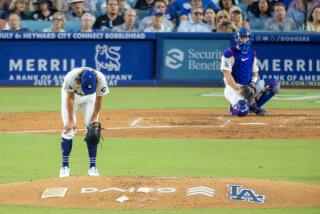He’s Not What He Appears
- Share via
Everyone agreed that Mark Langston was “a good-looking young pitcher.” All the scouts, managers, hitters--and young ladies.
It wasn’t that he had this hellacious fastball (although he did) or this wicked curveball. It was that he had these blue eyes, dimpled cheeks, smooth skin, a nice smile and curly hair.
You know how baseball is. It likes its pitchers with barbed-wire beards, a permanent scowl, a chaw of tobacco, a spitball, legal or not, and the physiognomy, generally, of the villain in a Western.
So, Mark Langston had a credibility problem. Some teams wondered what surfboard they found him on. Others thought they just picked him up on the way to a male-model fashion shoot. Why would a guy with matinee-idol looks want to spend his life trying to smuggle a fastball past Jose Canseco?
The answer was, Langston had a fastball that even Canseco would have trouble getting around on.
At first, that was almost all he had. He was a thrower good enough to send batters back to the dugout with just his speed. All he had to do was get it over. It didn’t have to bend, dip, sink. It just went right past you.
His fast one burned up the minor leagues. Then, in his first season in the big leagues, at Seattle, he won 17 games and led the American League in strikeouts with 204. He probably should have been rookie of the year, but that honor went to teammate Alvin Davis.
Still, no one called him Dr. K. In fact, no one called him much of anything. They could have called him Dr. Who? He pitched for the Seattle Mariners, which was just better than being in the CIA for getting your picture in the paper.
His manager, Dick Williams, didn’t help matters much when he delivered himself of the opinion that Langston had a great arm but his heart didn’t match.
Now, you have to understand Dick Williams. He would question the dedication of the man-eating shark. Or Jack Dempsey or Nathan Hale, for that matter. Williams considered giving up a home run a character flaw.
Once again, the Langston looks seemed to have sold him short. He should have glowered more or smashed a few light bulbs in the locker room or knocked out the water cooler. Managers like that.
Actually, Langston won 19 games for Williams one year and 15 the next, which makes you wonder what Williams found wanting. He led the league in strikeouts two years in a row--which is hardly giving in to the hitters.
It’s hard to challenge the fortitude of anyone who would pitch in the Seattle Kingdome anyway. This is a ballpark where the power alleys are so intimate, the umpires are calling the infield-fly rule on pops that end up over the fence. Pitching there is like going into a cellar after a wildcat.
Despite his record, though, Langston kind of knew what they meant. In baseball, when you over-rely on one pitch, you are identified as a kind of dilettante. You are a thrower, not a pitcher. The distinction is subtle. A thrower is a one-speed automaton. He’s effective only when everything is in order--the temperature is right, the mound is right, the arm feels OK, the blood pressure is in range and the umpire gives you a generous strike zone.
A pitcher can get you out when his horoscope is all screwed up, his head hurts, his teeth ache, his fastball doesn’t hum and the curve tends to hang. Langston gets you out. He won 19 games last year for the Angels, and even in his “off” year for them, 1990, when he was 10-17, he won five of his last seven. He has more than one “out” pitch now.
“To be an effective pitcher, you have to have more than a 95-m.p.h. fastball,” he acknowledges. “The three keys to successful pitching are: 1) velocity; 2) location, and 3) movement.
“With some batters, you have to throw to a place, a place where you know they can’t handle it.
“There are other things you learn. It’s important to get ahead of the hitter. Some hitters will let you do this. Others are more aggressive. You have to know which you’re dealing with. It dictates what you throw and where you throw it.
“You see, if you get ahead of the hitter, he’s pressing. You can get him out on a non-strike because he’s overanxious. Very few hitters are good two-strike hitters. Almost nobody wants to risk being called out with the bat on his shoulder. You make that work to your advantage. When you’re ahead, you can get him lunging.
“But, if you get behind a hitter, the reverse is true. Now, you have taken away two of your pitches. You have now eliminated the changeup from your pitching options. If you’re ahead, you can throw curves that aren’t strikes. If you’re behind, you have to come in with a strike. It’s like the hitter knows you don’t have any aces in your hand.”
Langston has four pitches: fastball, a pitch he calls a “slurve”--half slider, half curve--a changeup and a slow curve.
“I need for the batter to be looking for all four pitches,” he says. “If you lose two pitches by being behind in the count, you’re playing his game.”
Langston says he has had to learn to protect the strike zone, too.
“If a hitter leans over the plate, he is taking part of it away from you. A plate is--what?--18 inches (actually 17) and if you want it, you have to move him off it.”
So, the good looks are camouflage. Langston is like the choir boy who is the chain-saw murderer. Never mind the blue-eyed stare, the even teeth, the wide smile. Underneath all that is Burleigh Grimes, waiting to throw the ball past you--or through you, if you hang over the plate.
More to Read
Go beyond the scoreboard
Get the latest on L.A.'s teams in the daily Sports Report newsletter.
You may occasionally receive promotional content from the Los Angeles Times.










